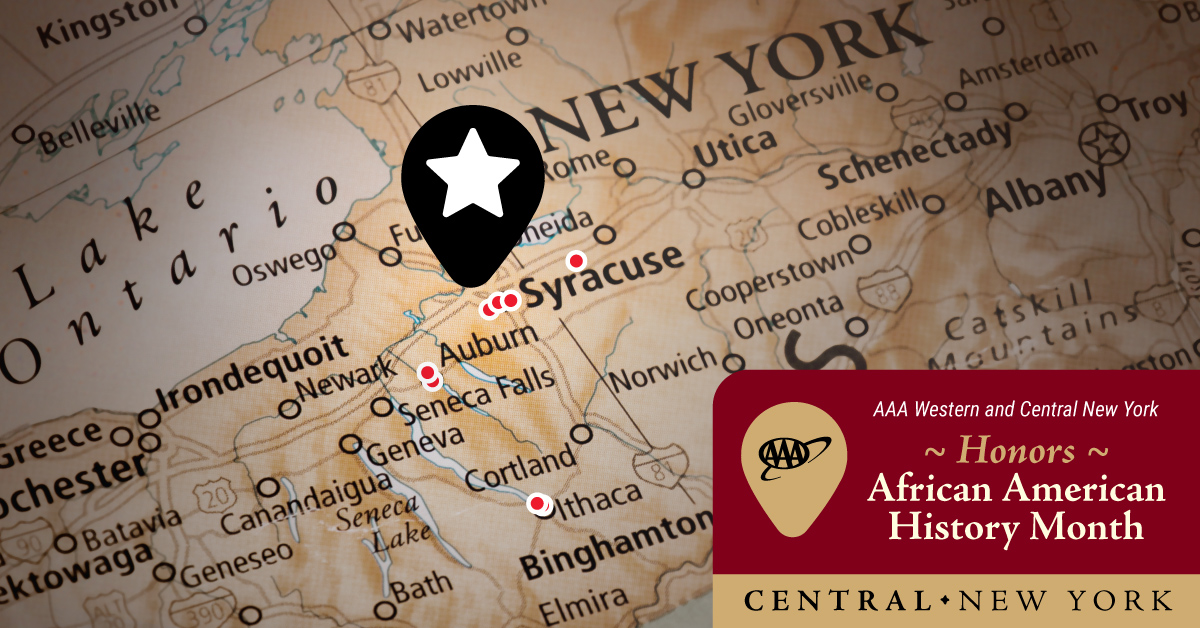AAA Honors African American History in Central New York
AAA Honors African American History in Central New York

This month, AAA is spotlighting local places and sites that helped shape African American history. One region with a deep history in the abolitionist movement in Central New York.
From the Freedom Trail to the Harriet Tubman Home, learn more about these important places in Central New York.
-
Freedom Trail Syracuse
This self-guided tour commemorates the places, people, and events of the 19th century abolitionist movement. Along the trail, you can see signs and markers that share information and historical lessons of the movement.
This includes the Jerry Rescue Monument, which marks the Jerry Rescue in 1851 when 2,000-3,000 black and white Syracuse residents took action to rescue a free runaway slave who had been captured by marshals; Plymouth Church, which hosted many abolitionist conventions and whose members were primary organizers of the Freedom Trail; Courier Building where Daniel Webster declared in 1851 that resistance to the Fugitive Slave Law was treason – the crowd, in response, banded together and freed an escaped slave (the Jerry Rescue), and the Mission restaurant, formerly the Wesleyan Methodist Church whose congregation was dedicated to the service of freeing slaves, was instrumental in the Jerry Rescue; and contains a tunnel below it that was once used in the Underground Railroad.
- 304 E Onondaga St, Syracuse Mission
- Clinton Square Syracuse Jerry Rescue
- 210 Montgomery St, Syracuse, Courier Building
- 232 E Onondaga St, Syracuse, Plymouth Church
-
Barnes Hiscock Mansion 930 James St, Syracuse
George Barnes, a businessman in Syracuse in the mid-19th century became a part of the anti-slavery movement through the Universalist Church. He hosted meetings for the abolitionist movement in the house for freedom seekers to help them either move to Canada or stay in Syracuse, and it’s believed that they housed fugitive slaves there. He also played a role in the Jerry Rescue and posted bail for some of the people who were arrested trying to help Jerry during the rescue. Interesting fact: in the home is an original painting of two children together – a black child and a white child. The inclusion of the black child in the painting was a secret code to guests passing through the home that the family was anti-slavery.
-
Wilcox House (Octagon House) 5420 W Genesee St, Camillus
The Wilcox House was the home of Isaiah Wilcox. An anti-slavery deacon of the Camillus Baptist Church, he built his landmark home on the land that he used as a large sheep and cattle farm. The home used plans very popular at the time by Orson Fowler, who wrote a book promoting the use of octagonal home designs and was rumored to be part of the Underground Railroad.
-
Seward House Museum 33 South Street, Auburn
William Seward was a Secretary of State for Lincoln and Johnson, a New York State Senator, a United States Senator, and Governor of New York. His house in Auburn was a stop on the Underground Railroad and he and his wife often hid escaped slaves in their basement. The Sewards had a close relationship with Harriet Tubman, and they were the ones who proposed that she come to Auburn.
-
Harriet Tubman Home 180 South Street, Auburn
Tubman, a major conductor on the Underground Railroad moved to Auburn with her parents after living in St. Catharines, Ontario at the suggestion of then-U.S. Senator William Seward. Seward sold her the home which, at the time, was considered an illegal transaction. She stayed in Auburn until her death in 1913.
-
National Abolition Hall of Fame and Museum 5255 Pleasant Valley Road, Peterboro
This museum in Madison County is located in the building where the first meeting of the New York State Antislavery Society was held in 1835. The Hall of Fame inducts new honorees every 2 years for dedicating their lives and resources to the pursuit of equal rights for all people.
-
St. James A.M.E. Zion Church 116 Cleveland Avenue, Ithaca
This is the oldest surviving church in Ithaca, is a cornerstone of the local African American community. It served as a station on the Underground Railroad during the 19th century and hosted Harriet Tubman and Frederick Douglass. It’s part of the national African Methodist Episcopal Zion Church (known as the “Freedom Church”) that helped galvanize the civil rights movement.
-
The Dennis-Newton House 421 North Albany Street, Ithaca
The Dennis-Newton House is where the nation’s first African American fraternity – Alpha Phi Alpha – was founded. The house was owned by the Dennis family. Norman Dennis, an Ithaca resident, helped found the first African-American lodge of the Odd Fellows in Elmira. His daughter married Edward Newton, who worked at the Psi Upsilon fraternity house at Cornell University. Edward Newton used the house to host the social study group of African American male students at Cornell. This group eventually became the Alpha Phi Alpha fraternity.
Would you like to tour these locations related to African American history? Use a AAA TripTik! Download the PDF version, or use the online TripTik below to help you navigate your journey!












